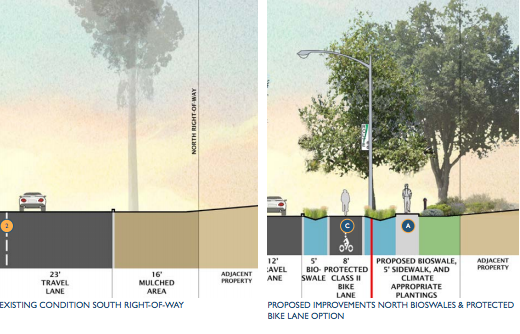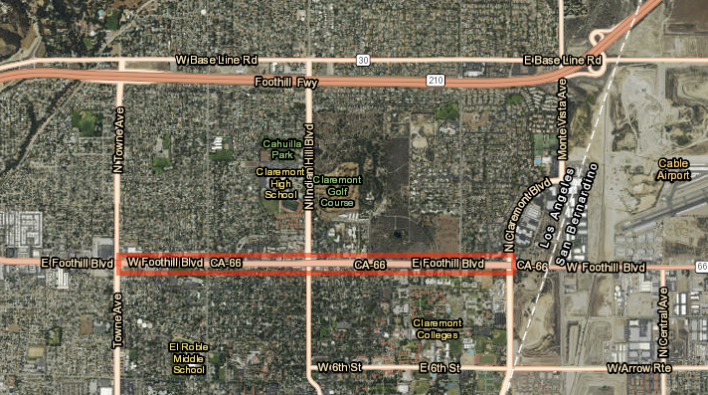
Immortalized by John Steinbeck as “The Mother Road,” the decommissioned Route 66, now known as Foothill Boulevard in East Los Angeles cities La Verne and Claremont, often draws nostalgic visions of America’s golden age of the automobiles. First established in 1926, Route 66’s creation marked the development of transcontinental highway systems in mid-century America.
As one might expect, much of Route 66’s bordering development in eastern Los Angeles County reflects the automobile-centric planning logic of a bygone era. Auto-centric strip malls, restaurants, and services still surround intimidatingly wide Foothill Boulevard and serve as a reminder that Southern California still has a ways to go to overcome its overwhelming dependence on automobiles.
However, a recently approved $9.7 million complete-street project proposal in Claremont challenges the car centered-design of Foothill Boulevard, the former Route 66.
Approved in October of 2015, Claremont’s Foothill Boulevard Improvement Project aims to improve the street's accessibility, safety, and multi-modal additions with a complete-street approach to road planning.

Currently, Claremont’s section of Foothill Boulevard features dated Route 66 size proportions, including travel lane widths ranging from 17-23 feet. Typical surface street lanes would be 10-11 feet wide. Foothill’s unholy combination of over-sized lanes and absence of multi-modal transit features creates an intimidating atmosphere for pedestrians and cyclist. In addition to their impractical width, these Route-66 era lane widths, Claremont Senior Planner Chris Veirs noted, provoke faster driving speeds through speed creep and endanger all users of the road. In response, the Foothill Improvement Project calls for a series of “road dieting” measures and complete-street accommodations.

The fifteen-year project includes most of its major additions in the near term of 1-3 years in the corridor-phasing plan. Street improvements include, most notably, restriping with a road-diet, adding bicycle lanes across the entire length of Foothill, sidewalk bulb outs, and rain water bioswales. These pedestrian and cyclist-friendly improvements, Veirs explained, draws upon Claremont’s General Plan and Bicycle Plans goals to create a livable, mobile city more friendly to pedestrians, bicyclists and businesses. Foothill is bordered by popular businesses such as Trader Joes and Sprouts in addition to other major local institutions, such as the Claremont School of Theology and the Claremont Colleges.
Not all improvements, however, were warmly welcomed by nearby residents.
A staff-proposed sidewalk addition from N Mountain Avenue to Berkeley Avenue (area pictured below) was disputed by some neighborhood residents. Residents expressed the fear that a sidewalk addition bordering their properties would inhibit the privacy and safety of their neighborhood. Opposition included a 101-signature petition against sidewalk construction from Mountain to Berkeley. In response, the city council proceeded with an alternative staff plan without sidewalk construction along south side of the central portion of the project.

The initiative to improve Foothill's accessibility arose after Caltrans relinquished control of Foothill Boulevard to Claremont in 2012. This followed years of negotiation. Foothill was afflicted with bureaucratic state highway management and its lagging repair times. As part of the agreement, Caltrans gave Claremont $5.7 million for repairs and infrastructural updates to bring the road up to Caltrans standards. Thus the Foothill Improvement Project was born. Most of acquired funding for the Phase I plan is from Foothill relinquishment fund, supplemented by a Mobile Source Air Reduction Grant (MSRC) and a college developer fee.
While complete-street improvements to Claremont's Foothill Blvd appear limited in geographic scope when compared to L.A. County, efforts to re-design former state routes invite optimism for bicycle and pedestrian advocates. It is important progress that a former segment of Route 66, the road most associated with America’s golden age of automobiles and transnational highways, will soon share space with cyclists and pedestrians as a complete street.
For the complete city of Claremont Foothill Boulevard Improvements designs, click here.
SBLA coverage of San Gabriel Valley livability is supported by Foothill Transit. Foothill Transit has been a leader in sustainable transportation for years. And now they’re committed to having a 100% electric bus fleet by 2030. To celebrate, Foothill Transit is giving away prizes and sharing facts about how their electric buses help clear the air. Visit Foothill Transit’s e-bus sweepstakes webpage to see how you can join in the eco-friendly fun!






